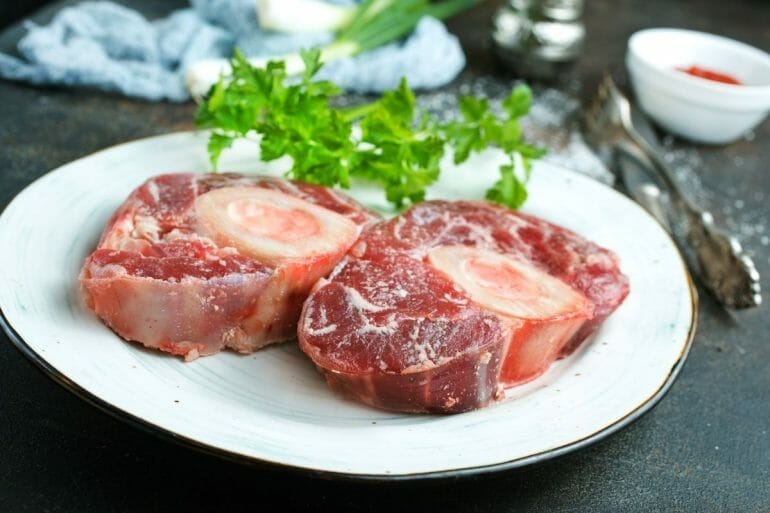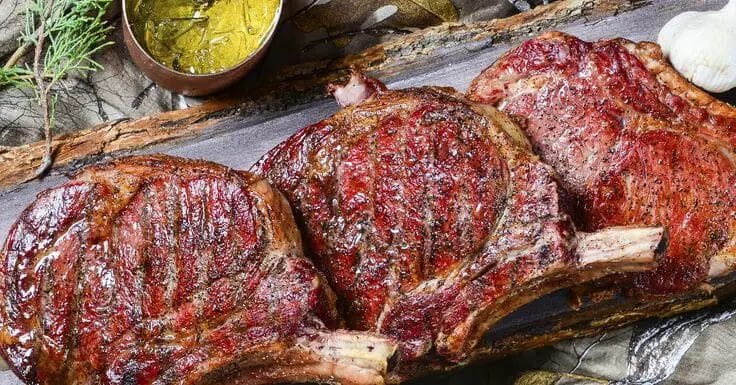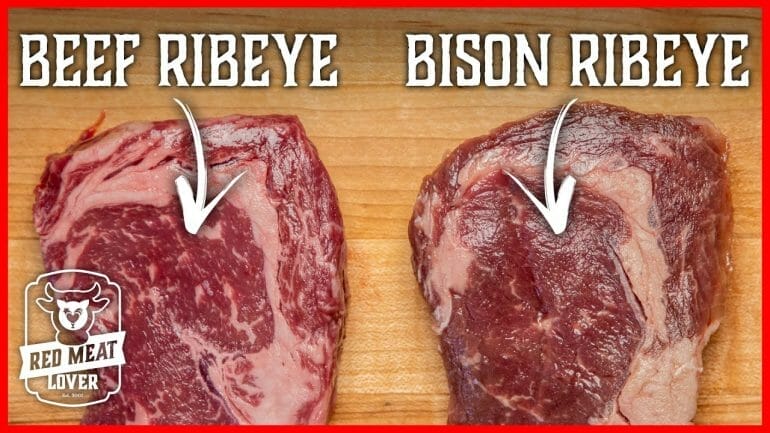Bison steak is a unique and flavorsome meat that offers a distinct taste experience.
Renowned for its rich and robust flavor, bison steak has been described as lean, tender, and slightly sweeter than beef.
With its low fat content and high protein, bison steak offers a healthier alternative to beef while maintaining a delicious and satisfying taste.
Prepare to indulge in a succulent and savory dining experience with bison steak, as it delivers a distinct flavor profile that is sure to tantalize your taste buds.

A Culinary Adventure: Unveiling the Unique Flavors of Bison Steak
When it comes to indulging in a delectable and unforgettable dining experience, few meats can rival the succulent taste of bison steak. Known for its lean yet flavorful nature, bison steak has become a sought-after delicacy among food enthusiasts and culinary connoisseurs.
The History and Heritage of Bison Steak
Bison, also known as American buffalo, has a rich history that dates back centuries. Native Americans revered the bison as a sacred animal, utilizing every part for their sustenance, clothing, and tools. With the preservation of bison populations and the rise of sustainable farming practices, bison meat has regained its popularity and found its way to the center of the culinary world.
The Unique Characteristics of Bison Steak
One of the main reasons bison steak stands out is its distinct flavor profile. The taste is often described as robust, earthy, and slightly sweeter than beef. Due to its lean composition, bison meat offers a tender texture that melts in your mouth. The lower fat content also means that bison steak cooks faster, making it an ideal option for those who crave a quick and delicious meal.
Health Benefits of Bison Meat
Bison meat is not only a treat for your taste buds but also a healthy choice. It is lower in fat and cholesterol compared to traditional beef, making it a leaner alternative without compromising on flavor. Additionally, bison meat is rich in essential nutrients such as iron, zinc, and B vitamins, providing a nutrient-dense option for those looking to maintain a well-balanced diet.
Culinary Tips for Cooking Bison Steak
To truly appreciate the unique flavors of bison steak, it is crucial to handle and cook it correctly. Here are some culinary tips to ensure a memorable dining experience:
- Allow the meat to come to room temperature before cooking to ensure even heat distribution.
- Marinate the steak for a few hours to enhance its tenderness and infuse flavors.
- Keep an eye on the cooking time as bison meat cooks faster due to its lower fat content.
- Rest the steak for a few minutes after cooking to allow the juices to redistribute, resulting in a more flavorful and tender bite.
Pairing Bison Steak with Complementary Flavors
To elevate your bison steak experience, consider pairing it with ingredients that complement its unique flavors. Here are some flavorful combinations:
| Bison Steak Cut | Complementary Flavors |
|---|---|
| Filet Mignon | Roasted garlic, red wine reduction |
| Striploin | Caramelized onions, blue cheese |
| Ribeye | Wild mushrooms, truffle butter |
In Summary
A culinary adventure awaits those who dare to explore the unique flavors of bison steak. From its rich history to its distinct taste, bison steak offers a one-of-a-kind dining experience that is sure to delight even the most discerning palates. Whether you’re a seasoned bison lover or a curious food enthusiast, indulging in a perfectly cooked bison steak is an experience worth savoring.

Savory Delights: Discovering the Rich Taste of Bison Steak
Bison steak is a true culinary gem that offers a rich and indulgent eating experience. This exquisite meat boasts a unique flavor profile that sets it apart from traditional beef steaks. In this section, we will delve into the world of bison steak and explore why it has become a favorite among food enthusiasts.
The Flavorful Difference
While beef steaks have their own appeal, bison steak brings something extra to the table. The meat’s flavor is often described as earthy and slightly sweeter than beef, with a hint of gamey undertones. This distinct taste can be attributed to the bison’s natural diet of grass and foraged plants, which adds complexity to the meat’s flavor profile.
Bison meat is also leaner than beef, making it a healthier alternative for steak lovers. It has lower fat content and fewer calories, making it an ideal choice for those watching their dietary intake. Despite being lean, bison steak remains tender and juicy when cooked properly, ensuring a satisfying dining experience.
Health Benefits of Bison Steak
Bison steak is not just a delight for the taste buds; it also offers several health benefits. The lean nature of bison meat means that it contains less saturated fat compared to beef, making it a heart-healthy choice. Bison steak is also rich in protein, iron, and essential amino acids, making it a nutritious option for those looking to maintain a balanced diet.
Additionally, bison meat is often sourced from grass-fed and free-range animals, which means it is free from added hormones and antibiotics. This makes it a wholesome and natural choice for conscious consumers who prioritize sustainable and ethical food sources.
Cooking Tips for Bison Steak
Cooking bison steak requires some adjustments compared to beef steak. Due to its lower fat content, it is recommended to cook bison steak to medium-rare or medium doneness to avoid drying it out. The lean nature of the meat also means that marinating or using a dry rub can enhance the flavors and help tenderize the steak.
When grilling or pan-searing bison steak, it is important to use moderate heat to prevent overcooking and ensure that the meat remains juicy. Resting the steak after cooking is crucial to allow the juices to redistribute, resulting in a moist and succulent piece of meat.
Pairings and Serving Suggestions
To complement the robust flavors of bison steak, consider pairing it with bold and savory accompaniments. Rich red wine, such as Cabernet Sauvignon or Syrah, can beautifully enhance the flavors of the meat. As for side dishes, roasted root vegetables, garlic mashed potatoes, or a fresh salad with a tangy vinaigrette can provide a well-rounded meal.
For a truly unforgettable dining experience, serving bison steak alongside a flavorful sauce, such as a red wine reduction or a savory mushroom sauce, can take the dish to new heights. The sauce adds depth and richness to the already delightful flavors of the bison steak.
In summary, bison steak offers a delectable alternative to traditional beef steaks. Its unique flavor, combined with its health benefits and versatility in cooking, makes it a sought-after choice for meat lovers. Whether grilled to perfection or seared on a hot pan, bison steak promises to tantalize the taste buds and leave a lasting impression. So, embark on a culinary adventure and discover the rich taste of bison steak for yourself.

4. Gastronomic Delights: Indulging in the Delectable Flavors of Bison Steak
When it comes to indulging in a truly unforgettable culinary experience, few meats can rival the mouthwatering flavors and succulence of bison steak. The unique taste and texture of bison meat make it a sought-after delicacy for meat enthusiasts and food connoisseurs alike. In this section, we will dive into the world of gastronomic delights offered by bison steak, exploring its distinct qualities, cooking techniques, and why it deserves a place on your plate.
The Distinctive Qualities of Bison Meat
Bison meat, known for its rich, lean, and tender characteristics, offers a flavor profile that sets it apart from other types of meat. With a slightly sweet and robust taste, bison steak provides a unique palate experience that is both satisfying and memorable. This meat is exceptionally lean, boasting a low fat content compared to traditional beef, making it a healthier option without compromising on taste.
Furthermore, bison meat is packed with essential nutrients, making it a nutritious choice for those seeking a balance between indulgence and wellness. It is a great source of high-quality protein, iron, and essential amino acids, which are vital for maintaining overall health and wellbeing. Incorporating bison steak into your diet allows you to savor a delectable meal while reaping the nutritional benefits it provides.
Cooking Techniques for Bison Steak
To truly appreciate and unlock the full potential of bison steak, it is crucial to employ the right cooking techniques. Due to its low fat content, bison meat requires careful handling and precision to ensure a tender and juicy result. Here are a few recommended cooking methods to bring out the best flavors from your bison steak:
- Grilling: Grilling bison steak over high heat helps to seal in the juices and develop a flavorful crust on the outside, while preserving the tenderness within. It is essential to monitor the cooking time closely to prevent overcooking and maintain the desired level of doneness.
- Searing: Searing the bison steak in a hot skillet before finishing it in the oven allows for a caramelized exterior and a perfectly cooked center. This method works exceptionally well for thicker cuts of bison steak.
- Marinating: Marinating the bison steak prior to cooking can enhance its tenderness and infuse it with additional flavors. Opt for marinades that complement the natural richness of bison meat without overpowering its unique taste.
Why Bison Steak Deserves a Place on Your Plate
Beyond its exceptional taste and versatility in the kitchen, bison steak offers a range of benefits that make it a standout choice for meat lovers. Firstly, bison are typically raised in a more sustainable and humane manner compared to conventional livestock. They roam freely and graze on natural grasses, resulting in a more environmentally friendly and ethically conscious source of meat.
Secondly, bison meat is lower in fat and calories compared to traditional beef, making it a healthier option for those watching their dietary intake. It is also free from antibiotics and hormones commonly used in commercial livestock production, ensuring a cleaner and more natural meat for consumption.
Lastly, by opting for bison steak, you are supporting local farmers and ranchers who are committed to preserving the rich heritage and legacy of bison farming. By choosing this sustainable and flavorsome meat, you contribute to the conservation efforts aimed at protecting these magnificent animals and their habitats.
In Summary
Indulging in the delectable flavors of bison steak is a culinary experience like no other. With its unique taste, lean composition, and rich nutrient profile, bison meat offers a healthy and delicious alternative to traditional beef. By employing the right cooking techniques, such as grilling, searing, or marinating, you can unlock the full potential of bison steak and create a memorable dining experience. Beyond its exquisite flavors, choosing bison steak demonstrates your commitment to sustainability and supports local farmers. So, why not treat yourself to the gastronomic delights of bison steak and savor the extraordinary flavors it has to offer?
5. Elevated Dining Experience: Savor the Distinctive Taste of Bison Steak
When it comes to elevating your dining experience, few things can compare to indulging in the distinctive taste of bison steak. With its rich flavor, tender texture, and numerous health benefits, bison steak offers a truly unique and satisfying culinary experience.
Bison, also known as American buffalo, is a majestic animal that roams across the vast grasslands of North America. It has been a staple in the diets of Native American tribes for centuries, and now it is gaining popularity among food enthusiasts and health-conscious individuals alike.
One of the main reasons why bison steak stands out is its exceptional taste. The meat has a distinctively rich and savory flavor that is often described as slightly sweeter and more robust than beef. This unique taste is a result of the bison’s natural diet of grasses, which gives the meat a deeper, more complex flavor profile.
In addition to its exceptional taste, bison steak is also known for its tender and juicy texture. The meat is leaner than beef, which means it cooks faster and requires less time on the grill or in the oven. Despite being lean, bison steak remains incredibly tender and moist, making it a delight to bite into.
Furthermore, bison steak offers a range of health benefits that make it an excellent choice for those looking to improve their diet. Bison is lower in fat and calories compared to beef, making it a healthier option for those watching their waistline. It is also rich in protein, iron, and essential amino acids, all of which are vital for maintaining good health.
When it comes to preparing bison steak, there are various cooking methods that can further enhance its flavor and texture. Grilling is a popular choice as it helps to sear the meat and lock in its natural juices. However, bison steak can also be pan-seared, broiled, or prepared in the oven to achieve delicious results.
To fully savor the distinctive taste of bison steak, it is recommended to pair it with complementary flavors and ingredients. A simple seasoning of salt, pepper, and garlic can accentuate the natural flavors of the meat. Additionally, adding a touch of fresh herbs, such as rosemary or thyme, can bring a refreshing and aromatic element to the dish.
For those seeking a more indulgent experience, bison steak can be accompanied by a variety of side dishes and sauces. Creamy mashed potatoes, roasted seasonal vegetables, or a tangy blue cheese sauce can all complement the rich flavors of the meat and elevate the overall dining experience.
In summary, savoring the distinctive taste of bison steak offers an elevated dining experience like no other. With its rich flavor, tender texture, and numerous health benefits, bison steak stands out as a unique and satisfying choice for food enthusiasts. Whether grilled, pan-seared, or prepared in the oven, bison steak is bound to delight your taste buds and leave you craving more.
FAQs
1. What does bison steak taste like?
Bison steak has a rich and slightly sweet flavor. It is often described as being similar to beef but with a slightly stronger and more robust taste. The meat is lean and tender, making it a popular choice for those looking for a healthier alternative to beef.
2. How do I cook bison steak?
Bison steak can be cooked similarly to beef steak. It is best to cook it on high heat for a shorter amount of time to prevent it from drying out. Bison is leaner than beef, so it is important not to overcook it. Aim for medium-rare to medium doneness for the best results.
3. Is bison steak healthier than beef?
Yes, bison steak is generally considered a healthier option compared to beef. Bison meat is leaner and lower in fat, calories, and cholesterol. It is also higher in protein and contains more beneficial nutrients such as iron and omega-3 fatty acids.
Conclusion:
In conclusion, bison steak offers a unique and flavorful dining experience. The taste of bison steak can be described as rich, slightly sweet, and slightly gamey. Its lean nature makes it a healthier alternative to traditional beef steak. The distinct flavor and tender texture make bison steak a favorite among meat enthusiasts. Whether grilled, pan-seared, or roasted, bison steak is a delicious and nutritious option for steak lovers.
Moreover, bison meat offers a lower fat content and higher protein content compared to beef, making it a popular choice for health-conscious individuals. The natural grazing and free-range lifestyle of bison contribute to their exceptional taste and quality. So, if you’re looking for a flavorful and healthier steak option, bison steak is definitely worth a try!

